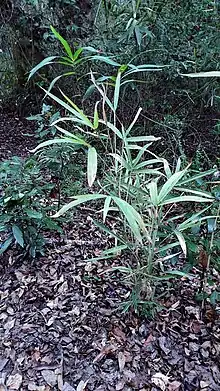| Arundinaria tecta | |
|---|---|
 | |
| Scientific classification | |
| Kingdom: | Plantae |
| Clade: | Tracheophytes |
| Clade: | Angiosperms |
| Clade: | Monocots |
| Clade: | Commelinids |
| Order: | Poales |
| Family: | Poaceae |
| Genus: | Arundinaria |
| Species: | A. tecta |
| Binomial name | |
| Arundinaria tecta (Walter) Muhl. | |
Arundinaria tecta, or switchcane,[1] is a bamboo species native to the Southeast United States,[1][2] first studied in 1813.[3] It serves as host to several butterfly species.[4] The species typically occurs in palustrine wetlands,[5] swamps, small to medium blackwater rivers, on deep peat in pocosins, and in small seepages with organic soils.[6] The species is only known to occur in the Atlantic Plain, Gulf Coastal Plain, and Mississippi Embayment, though it was earlier thought to exist in the Piedmont and Southern Appalachians as well. Specimens from the uplands are now thought to be a separate but morphologically similar species, Arundinaria appalachiana.
Description


Arundinaria tecta is a low and slender bamboo that branches in its upper half, growing up to 0.6–4 m (2 ft 0 in – 13 ft 1 in) in height. A. tecta features long primary branches usually greater than 50 centimetres (20 in) in length.[6] The leaves are 8–20 cm (3.1–7.9 in) long and 0.8–3 cm (0.31–1.18 in) wide, tapering in width towards their base. Both leaf surfaces are densely pubescent. The midculm leaves of A. tecta are longer than their associated internodes. The panicles are borne on shoots that grow directly from the rhizomes. Rhizomes feature continuous air canals.[6] Each panicle has a few clustered spikelets on slender branches. These branches have loose sheaths with minute leaves. The spikelets are 2.5–5 cm (0.98–1.97 in) long and have five to ten flowers.[7]
The plant flowers from March to June. Flowering can be stimulated by fire.[6]

See also
References
- 1 2 "Plants Profile for Arundinaria tecta (switchcane)". plants.usda.gov. Retrieved 2017-07-29.
- ↑ Hitchcock, Albert Spear; Chase, Agnes (1951). Manual of the Grasses of the United States. U.S. Department of Agriculture. p. 824.
Arundinaria tecta.
- ↑ Ohrnberger, D. (1999-01-29). The Bamboos of the World: Annotated Nomenclature and Literature of the Species and the Higher and Lower Taxa. Elsevier. ISBN 9780080542386.
- ↑ Scott, James A. (1992-03-01). The Butterflies of North America: A Natural History and Field Guide. Stanford University Press. ISBN 9780804720137.
- ↑ Burton Edward Livingston, Forrest Shreve (1921). The Distribution of Vegetation in the United States: As Related to Climatic Conditions. Carnegie Institution of Washington publication. Vol. 284. Carnegie institution of Washington. p. 85.
- 1 2 3 4 Triplett, J.K.; Weakley, A.S.; Clark, L.G. (2006), "Hill cane (Arundinaria appalachiana), a new species of bamboo (Poaceae: Bambusoideae) from the southern Appalachian Mountains" (PDF), Sida, 22 (1): 79–95, archived from the original (PDF) on 2007-09-30, retrieved 2007-07-14
{{citation}}: CS1 maint: multiple names: authors list (link) - ↑ Merrit Lyndon Fernald (1970). R. C. Rollins (ed.). Gray's Manual of Botany (Eighth (Centennial) - Illustrated ed.). D. Van Nostrand Company. p. 96. ISBN 0-442-22250-5.